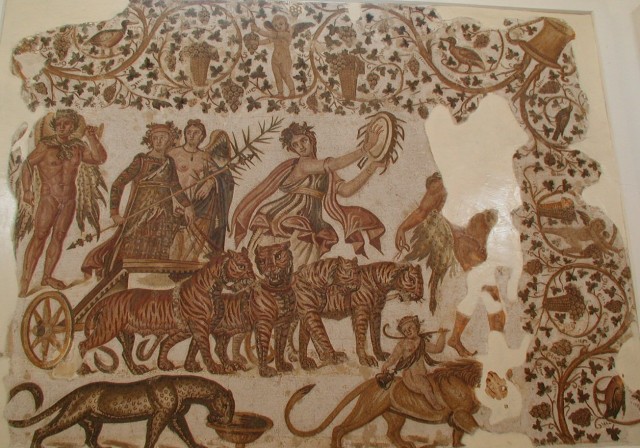Tympanum (hand drum) on:
[Wikipedia]
[Google]
[Amazon]
 In
In
File:Bronze statuette of Cybele.jpg, Cybele holding a ''tympanum'' in her left hand
File:Pompeii - Villa del Cicerone - Street Musicians Detail 3 - MAN.jpg, Tympanum player from a mosaic depicting a musical group
File:Israeli National Maritime Museum- Fgurine Iron Age IIb.jpg, Terracotta figurine from
VROMA Project: Tympanum
 In
In ancient Greece
Ancient Greece ( el, Ἑλλάς, Hellás) was a northeastern Mediterranean civilization, existing from the Greek Dark Ages of the 12th–9th centuries BC to the end of classical antiquity ( AD 600), that comprised a loose collection of cu ...
and Rome
, established_title = Founded
, established_date = 753 BC
, founder = King Romulus ( legendary)
, image_map = Map of comune of Rome (metropolitan city of Capital Rome, region Lazio, Italy).svg
, map_caption ...
, the () or , was a type of frame drum or tambourine
The tambourine is a musical instrument in the percussion family consisting of a frame, often of wood or plastic, with pairs of small metal jingles, called " zills". Classically the term tambourine denotes an instrument with a drumhead, tho ...
. It was circular, shallow, and beaten with the palm of the hand or a stick. Some representations show decorations or zill-like objects around the rim. The instrument was played by worshippers in the rites of Dionysus
In ancient Greek religion and Greek mythology, myth, Dionysus (; grc, wikt:Διόνυσος, Διόνυσος ) is the god of the grape-harvest, winemaking, orchards and fruit, vegetation, fertility, insanity, ritual madness, religious ecstas ...
, Cybele, and Sabazius.
The instrument came to Rome from Greece and the Near East
The ''Near East''; he, המזרח הקרוב; arc, ܕܢܚܐ ܩܪܒ; fa, خاور نزدیک, Xāvar-e nazdik; tr, Yakın Doğu is a geographical term which roughly encompasses a transcontinental region in Western Asia, that was once the hist ...
, probably in association with the cult of Cybele. The first depiction in Greek art appears in the 8th century BC, on a bronze votive disc found in a cave on Crete
Crete ( el, Κρήτη, translit=, Modern: , Ancient: ) is the largest and most populous of the Greek islands, the 88th largest island in the world and the fifth largest island in the Mediterranean Sea, after Sicily, Sardinia, Cyprus, ...
that was a cult site for Zeus
Zeus or , , ; grc, Δῐός, ''Diós'', label= genitive Boeotian Aeolic and Laconian grc-dor, Δεύς, Deús ; grc, Δέος, ''Déos'', label= genitive el, Δίας, ''Días'' () is the sky and thunder god in ancient Greek relig ...
.
Dionysian rites
The ''tympanum'' is one of the objects often carried in the '' thiasos'', the retinue of Dionysus. The instrument is typically played by amaenad
In Greek mythology, maenads (; grc, μαινάδες ) were the female followers of Dionysus and the most significant members of the Thiasus, the god's retinue. Their name literally translates as "raving ones". Maenads were known as Bassarids ...
, while wind instruments such as pipes
Pipe(s), PIPE(S) or piping may refer to:
Objects
* Pipe (fluid conveyance), a hollow cylinder following certain dimension rules
** Piping, the use of pipes in industry
* Smoking pipe
** Tobacco pipe
* Half-pipe and quarter pipe, semi-circula ...
or the ''aulos
An ''aulos'' ( grc, αὐλός, plural , ''auloi'') or ''tibia'' (Latin) was an ancient Greek wind instrument, depicted often in art and also attested by archaeology.
Though ''aulos'' is often translated as "flute" or " double flute", it was u ...
'' are played by satyr
In Greek mythology, a satyr ( grc-gre, σάτυρος, sátyros, ), also known as a silenus or ''silenos'' ( grc-gre, σειληνός ), is a male nature spirit with ears and a tail resembling those of a horse, as well as a permanent, ex ...
s. The performance of frenzied music contributed to achieving the ecstatic state that Dionysian worshippers desired.
The cult of Cybele
The ''tympanum'' was the most common of the musical instruments associated with the rites of Cybele in the art and literature of Greece and Rome, but does not appear in representations fromAnatolia
Anatolia, tr, Anadolu Yarımadası), and the Anatolian plateau, also known as Asia Minor, is a large peninsula in Western Asia and the westernmost protrusion of the Asian continent. It constitutes the major part of modern-day Turkey. The re ...
, where the goddess originated. From the 6th century BC, the iconography of Cybele as ''Meter'' ("Mother", or in Latin ''Magna Mater'', "Great Mother") may show her with the ''tympanum'' balanced on her left arm, usually seated and with a lion on her lap or in attendance.Roller, ''In Search of God the Mother'', p. 136. The ''Homeric Hymn to the Great Mother'' says that the goddess loves the sound of the ''tympanum''. The drum continued to feature as an attribute of Cybele into the Roman Imperial era.
Gallery
Shikmona
Tel Shikmona ( he, תל שִׁקְמוֹנָה, translit= Šiqmônah), or Tell es-Samak ( ar, تل السمك, translit=Tell as-Samak), also spelt Sycamine, is an ancient Phoenician tell (mound) situated near the sea coast in the modern city of ...
, 2nd half of 8th century BCE
External links
VROMA Project: Tympanum
References
{{Greek musical instruments Ancient Greek musical instruments Ancient Roman musical instruments Cult of Dionysus Cybele Hand drums